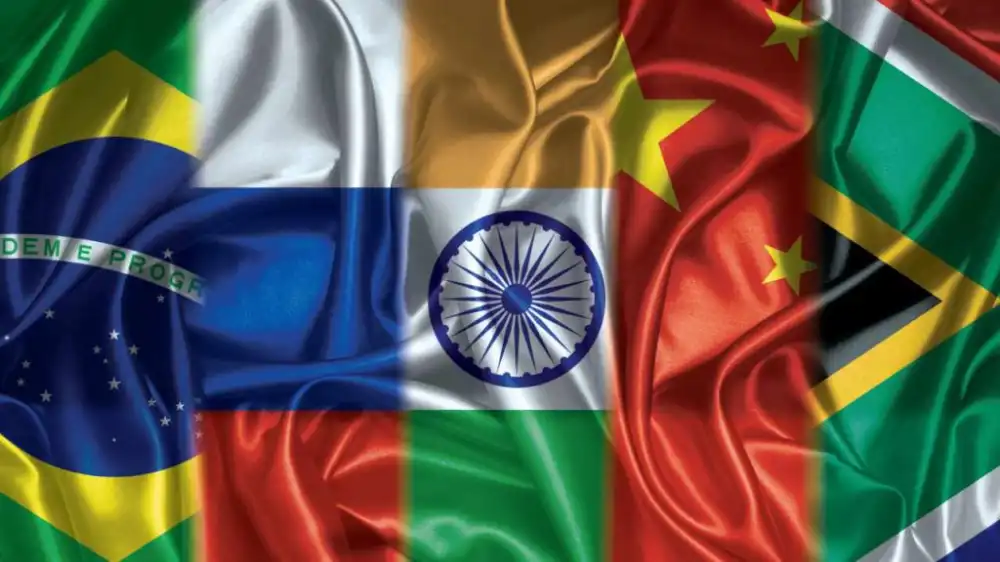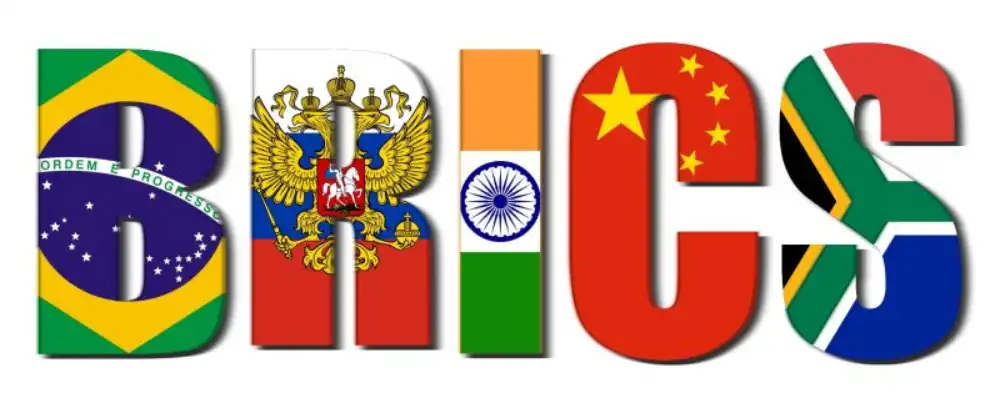BRICS Nations: New Members, New Goals, Challenges & Future Plans

British economist Jim O’Neill introduced the term “BRIC”. It was simply a way to describe a group of fast-growing economies then. He hinted that if these countries continue to grow at the same rate, they will become the world’s new economic power by 2050.
Few expected that idea to spark a movement capable of shifting the global balance. After South Africa joined, the bloc expanded to become BRICS.
For years, the United States and its allies shaped global trade, finance, and politics. But today, things seem slightly different, and the future predicts a tight competition for economic power between the U.S. and the BRICS nations.
Rather than forming alliances based on shared political systems, the BRICS unite around a common goal: building alternatives to Western-led institutions and currencies. They have launched their development banks, aiming to trade in local currencies, and have ideas for a joint BRICS currency. Each move signals a growing desire to shift global power centers eastward and southward.
By 2024, the group’s influence had moved from theory to reality. At this point, Trump threatens 100% tariffs on BRICS nations that abandon the US dollar. It shows just how serious the situation has become. The quiet rise of BRICS is now impossible to ignore.
But what exactly makes a BRICS nation? How did five countries, which have different cultures and geography, manage to align their interests? And what might their growing power mean for America’s role in the world? Let us find the answers.
What is a BRICS Nation?

The term BRICS nations refers to a group of major emerging economies: Brazil, Russia, India, China, and South Africa. These five countries represent some of the world’s fastest-growing markets and significantly influence trade, energy, technology, and finance.
Originally, economist Jim O’Neill coined the term ‘BRIC‘ in 2001 (before South Africa joined in 2010) to highlight the countries expected to drive global growth throughout the 21st century.
Each BRICS nation brings something unique to the table:
- Brazil boasts strong agricultural sectors and abundant natural resources.
- Russia holds immense energy reserves.
- India boasts a booming technology sector and a young workforce.
- China stands as a global manufacturing powerhouse.
- South Africa acts as the gateway to Africa’s emerging markets.
Today, this global alliance is practically taking steps to achieve its goal. How? With new initiatives like a proposed common currency and increased focus on BRICS nations’ national currency payments.
BRICS is no longer just an economic club. It is now seen as a potential challenger to the existing world order. With their reserves, they are building new institutions. Institutions like the New Development Bank and the Contingent Reserve Arrangement have started working.
As these nations strengthen their ties, their collective actions could reshape international finance and trade in ways that U.S. businesses, policymakers, and investors can no longer ignore.
Inside BRICS: How Big is the Internal Market?
BRICS members have traditionally faced barriers when trading among themselves, including significantly higher tariffs compared to their Western counterparts.
For example, internal BRICS tariffs average 8.4%, compared to just 1.1% among OECD nations. Yet, intra-BRICS trade is growing, reaching approximately $162 billion by 2023, demonstrating the huge untapped potential within the bloc.
Reducing these barriers by even half could inject billions more into their economies, pushing BRICS beyond a geopolitical statement into a real economic powerhouse.
BRICS Nations 2024 & 2025 Expansion
The BRICS nations list has changed dramatically in 2024, marking the most significant expansion in the group’s history. Initially, it was an alliance of only five countries: Brazil, Russia, India, China, and South Africa. However, at the last BRICS summit in South Africa, they recently sent invitations to several countries, and many of them joined in the same year.
Indonesia also joined the bloc as the newest member in January 2025. In addition, BRICS leaders claim that more than 20 countries, including several from Africa and Asia, are approaching them to join the bloc.
As of April 2025, the BRICS bloc now includes:
- Brazil
- Russia
- India
- China
- South Africa
- Egypt
- Ethiopia
- Iran
- Saudi Arabia
- United Arab Emirates
“This expansion has not only diversified the group’s economic strength but also its regional reach.”
- Africa now has a stronger voice thanks to countries like South Africa, Egypt, and Ethiopia.
- The Middle East has been spotlighted, with Iran, Saudi Arabia, and the UAE.
- Asia remains dominant, led by China and India, with countries like Bangladesh and Pakistan poised to join the bloc.
- South America is still represented by Brazil.
Saudi Arabia’s inclusion is still not confirmed. However, the country is actively participating in summits and discussions, but it has not officially joined the bloc. Several analysts suggest that this is a strategy to avoid conflict with the Western world.
Related: Check which BRICS countries want to join BRICS in 2025.
Inside the BRICS Bloc: Key Economic Powerhouses

It seems that BRICS is moving steadily with a clear strategy. The five countries already cover more than 30% of the world’s population and hold a significant share of global GDP, making them a powerful force in the global economy.
The addition of new countries is not random. Each new member brings something valuable: resources, market potential, or strategic influence. This careful expansion shows BRICS’ intent to strengthen its global position even further.
- Brazil is often called the “breadbasket of the world,” supplying major agricultural commodities such as soybeans, coffee, and beef. It is the largest economy in South America and a critical player in global food security.
- Russia: Russia has one of the world’s largest reserves of natural gas, oil, and minerals, so it remains a global energy powerhouse. Its strategic influence in Europe and Asia is tied closely to its resource exports.
- India: Now the most populous country, India’s young workforce and growing tech industry make it a future leader in services, manufacturing, and digital innovation.
- China: As the world’s second-largest economy, China dominates global manufacturing and supply chains. It is also a leader in infrastructure development, artificial intelligence, and green technologies.
- South Africa: As Africa’s most industrialized economy, South Africa serves as the continent’s financial and mining hub, rich in gold, platinum, and other valuable minerals.
With the 2024 expansion, new members bring even more economic diversity:
- Egypt, a gateway between Africa and the Middle East, is crucial in energy transit and trade.
- Ethiopia is one of Africa’s fastest-growing economies, offering potential in agriculture, textiles, and infrastructure.
- Iran, a major oil producer, strengthens the BRICS’ energy portfolio while adding new geopolitical leverage in Asia.
- Saudi Arabia: As the world’s largest crude oil exporter, Saudi Arabia’s inclusion significantly boosts the BRICS’ energy influence.
- The United Arab Emirates (UAE) is a global financial hub that brings significant capital, investment expertise, and a strategic location to the region.
The Money Behind the Movement: BRICS’ New Development Bank
New Development Bank (NDB) at a Glance:
| Metric | Statistic |
|---|---|
| Total Projects Approved | 96 |
| Total Funding Approved | $32 billion |
| Focus Areas | Sustainable infrastructure |
| Notable Initiatives | Green bonds, clean energy |
The NDB, established as a BRICS-led alternative to the World Bank, strategically finances projects in renewable energy, sustainable transport, and digital infrastructure. The NDB notably issued green bonds worth billions, attracting global investors eager for sustainable returns.
Expanding its membership beyond BRICS, including countries such as Bangladesh and Egypt, signals the BRICS’ broader ambition to reform international finance, promote sustainability, and create an alternative financial ecosystem beyond traditional Western institutions.
The Shift Toward BRICS National Currency Payments
One of the most significant ambitions driving the BRICS alliance today is reducing its reliance on the U.S. dollar. Instead, they are moving toward creating mechanisms that promote trade using a BRICS nation’s currency or direct national currency payments.
Why BRICS Wants Its Currency
The motivation is clear: dominance of the U.S. dollar gives Washington powerful leverage over global finance, including the ability to impose sanctions. By introducing a common currency or expanding the use of their national currencies for trade, member states aim to regain financial independence and create a more balanced world order. This shift could shield them from geopolitical pressures and allow more stable, localized trade agreements.
Recent Updates on National Currency Payment Systems
Several BRICS members have already begun experimenting with this idea. China and Russia now conduct most bilateral trade in yuan and rubles. India has pushed agreements with nations like the UAE and Russia to settle trades in rupees. South Africa is exploring more regional payment systems, while Brazil has discussed a potential common currency for South America that would be separate from the US dollar.
At the recent BRICS gatherings, leaders emphasized the development of a cross-border payment system that links their national currencies. Though still in progress, these efforts signal a serious intent to loosen the dollar’s grip on international trade.
Challenges and Opportunities
Launching a unified currency is no small task. The bloc’s members have very different:
- Economic structures
- Inflation rates
- Political systems
Agreeing on governance models, monetary policies, and valuation standards remains complex. However, success would offer enormous opportunities such as stronger regional trade, economic resilience against external shocks, and an alternative to Western-led financial institutions.
For now, BRICS seems to be taking a step-by-step approach. First, it will strengthen the BRICS nations’ national currency payments before moving toward a broader shared currency in the future.
BRICS Go Green: The Rise of South–South Eco-Tech Partnerships
An essential yet often overlooked aspect of BRICS cooperation is their commitment to sustainable and green technology initiatives. Through targeted South–South collaborations, BRICS members actively engage in technology transfer, emphasizing clean energy projects like solar power expansion in India and electric vehicle infrastructure in Brazil and South Africa.
The goal isn’t merely economic independence but responsible globalization. A recent comprehensive report highlighted BRICS’ commitment to sustainability, illustrating how environmental consciousness and economic growth aren’t mutually exclusive. These eco-friendly strategies are now central to BRICS’ economic diplomacy.
Trump’s Tariff Threats: A New Pressure Point for BRICS Bloc
In early 2025, President Trump warned that BRICS bloc countries moving away from the U.S. dollar could face 100% tariffs on their exports to the United States. This announcement came at a time when the BRICS alliance is trying to create a separate currency and a BRICS payment system.
Such a tariff move would represent a significant escalation in economic pressure. BRICS economies, such as China, India, Brazil, and South Africa, have substantial trade relationships with the U.S. 100% tariffs would not only affect these nations but also impact American importers. As a result, the cost of imported products would double, eventually disrupting global supply chains.
“You have this little group called BRICS. It’s fading out fast, but BRICS is, they wanted to try and take over the dollar, the dominance of the dollar, and the standard of the dollar.”
The threat highlights the United States’ strategic interest in defending the dollar’s global role. A successful transition by the BRICS bloc toward alternative currency systems could weaken U.S. leverage in international finance, trade negotiations, and the enforcement of sanctions.
Economists note that tariffs could temporarily discourage de-dollarization. However, they may also accelerate the long-term efforts of BRICS to build independent financial systems. By pushing these economies closer together, the policy could strengthen the shift it aims to prevent.
Trump’s aggressive stance marks a critical moment in the evolving financial landscape, where traditional power structures face serious challenges from emerging alliances like BRICS.
Understanding the Growth and Challenges of BRICS
The BRICS is entering a defining phase. Their expanding cooperation in alternative payment systems, energy trade, and digital infrastructure signals a broader ambition to build parallel frameworks to Western-dominated systems. However, success is far from guaranteed.
One major hurdle is economic imbalance within the group. China’s economy alone outpaces all other BRICS members combined. It creates concerns about disproportionate influence. India and Brazil, meanwhile, remain cautious about deepening political alliances that could limit their strategic autonomy. Internal challenges such as
- Political instability
- Regulatory inconsistencies
- Differing national priorities
It poses real barriers to coordinated action. Recent economic strains in Brazil and South Africa have also raised questions about the bloc’s long-term cohesion.
Global expectations continue to grow. Nations in Africa, Asia, and Latin America are increasingly considering BRICS+ as an alternative model. If the BRICS alliance builds credible institutions and offers tangible economic benefits, it could gradually reshape parts of global finance without needing complete dominance.
The next few years will be crucial. Success will depend less on ambitious declarations and more on delivering practical results in trade, investment, and monetary cooperation.
Will BRICS Nations Redraw the Global Economy?
The world is at a crossroads. BRICS bloc nations are no longer just participants in the global system; they probably aim to reshape it. As economic ties deepen and new strategies emerge, the traditional power structures built around the U.S. dollar and Western institutions could face their biggest challenge.
The real question is no longer if the BRICS bloc will impact the world economy. It is how soon and how deeply they will transform it. Are we witnessing the early stages of a new global era? Only time will tell, but ignoring these shifts could leave the West unprepared.
Liked this article?
Sign up for our newsletter to stay ahead of global trends!
Share this blog with others who care about the future of money and markets.
Join the conversation. Drop your thoughts in the comments below! We’d love to hear your thoughts.
Frequently Asked Questions
BRICS stands for Brazil, Russia, India, China, and South Africa, five major emerging economies working together to boost their global influence.
As of 2024, the BRICS group includes Brazil, Russia, India, China, South Africa, and newly added members such as Egypt, Iran, Ethiopia, Indonesia, and the United Arab Emirates.
The BRICS currency aims to reduce reliance on the U.S. dollar by promoting trade in national currencies among member nations.
Catagories
Recent Post
- Tired of Disconnected Systems? How Cloud Telephony + CRM Improves Efficiency
- Stealthly AI: Transforming AI Content into Authentic Human Text
- Why Weighted Grade Calculators Matter for Accurate Academic Planning
- Customize Your Phone Sound with a Free Online Ringtone Maker
- How to Use AI in Stock Trading for Smarter Decisions
